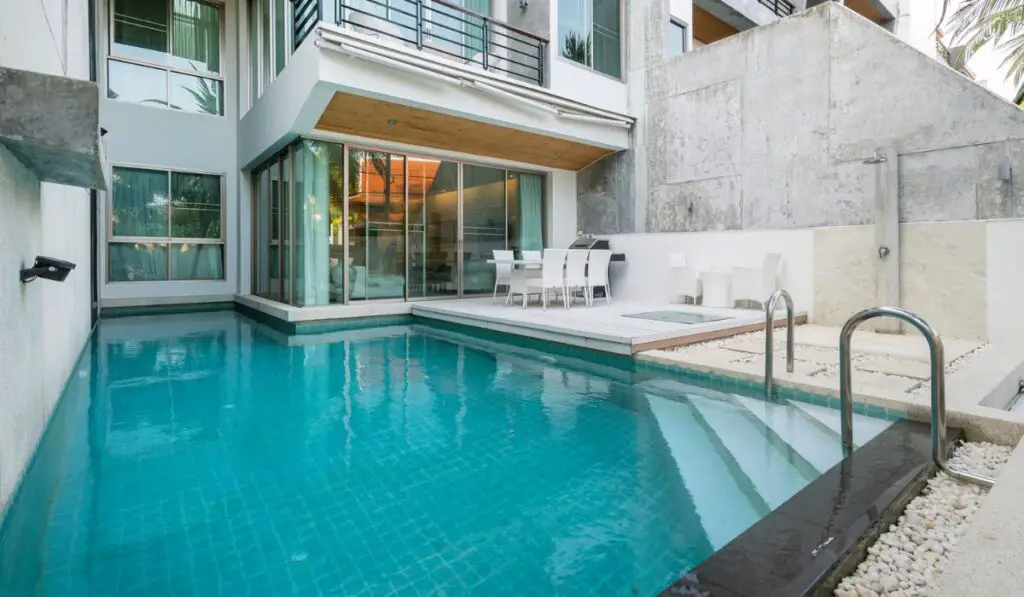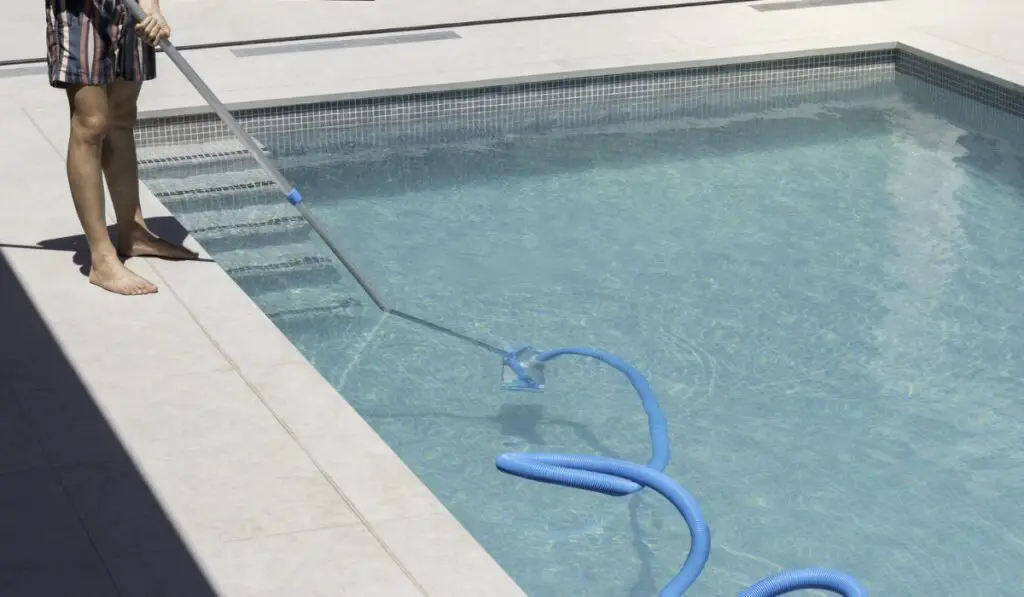Owning a pool is a dream for many homeowners. I mean, who doesn’t like the idea of lounging by the poolside, sipping a cold drink, and enjoying the summer breeze? However, there’s a lot to keep in mind before you can start receiving estimates.
Pools are expensive to install and maintain, so they’re best for households that will enjoy them often. Your budget, landscape, and interest in your home’s resale value are major factors in whether a pool is worth it. In general, you’ll get more bang for your buck if you live in a hotter climate.
It can be overwhelming to consider every factor that goes into a new pool installation. There’s a lot to think about, but becoming knowledgeable is the first step to making the right decision. Let’s discuss some of bigger issues to consider.
How to Decide if a Pool is Worth the Investment

Pools are a serious financial investment, and what you envision for your home is highly dependent on your circumstances. Besides the landscape and type of pool, you’ll also need to consider your planned usage and your climate. Here are some major factors to help you determine if a pool is worth the upfront costs.
Enjoyment
Whether you’ll make the most of your pool should be your primary concern. Chances are you’ll have your pool for at least five years after installation. Before you consider resale values and returns on your investment, ask yourself how much you’ll actually use your pool and enjoy it.
Do you host events and backyard barbecues? A pool can be a great focal point for events. If you have young children and plan to live in your home throughout their elementary and teenage years, pools are naturally a great place to make memories.
But a pool might not be right for you if you’re not highly social or like the idea of a hot tub better.
Climate
Swimming pools make an excellent addition to nearly any home. But they don’t make as much sense in colder climates and areas. Homes near the Pacific Northwest, Great Lakes, or Northeast probably won’t get as much use out of their pools.
Costs
Installing a swimming pool isn’t cheap. The average cost of building a swimming pool in the United States ranges from $17,000 to $45,000. Most homeowners pay around $30,500 for a new pool.
You’ll need to factor in maintenance costs after the upfront investment as well. This means paying as much as $7,000 per year for heating and filtration, depending on the size of your pool.
You’ll also have to consider the cost of additional features like diving boards and pool covers as well. Here’s the average range of costs for common add-ons:
- Pool covers: $600 to $2,200
- Diving board: $300 to $5,000
- Enclosures: $4,800 to $14,300
All in all, you might expect to pay an average of $500 to $4,000 a year on maintenance alone after the initial investment. If you’re still set on a pool, you can opt for smaller options, plunge models, or different materials to offset the costs.
Landscape
The landscape of your backyard or the space where you’re installing the pool is a major consideration. Along with the area you have, other variables include trees, rocks, and what land preparation will look like. Land preparation requires excavation, heavy machinery, and time.
In some cases, you’ll need to remove obstructions like large trees and rocks or level out the ground. You might need a smaller pool if you don’t have enough space. Your home’s property value might be negatively impacted if you opt for a larger pool without the necessary space.
What Does It Cost to Maintain a Pool?

Installing a new swimming pool isn’t a one-and-done job. You’ll have to regularly service and maintain your pool, which involves additional costs and time. Homeowners can expect to pay between $80 to $150 each month to maintain their pool.
You might pay around $960 to $1,800 yearly for maintenance alone. When you add in other factors, owning a pool can cost between $3,000 and $5,000 annually. Here’s a breakdown of what that might look like:
- Yearly Maintenance: $960 to $1,800
- Yearly Chemicals: $175 to $750
- Yearly Electricity: $800 to $1,200
- Yearly Water: $45 to $245
- Yearly Repairs: $400 to $1,000+
- Yearly Opening & Closing: $650 to $1,000
Pools require weekly or bi-weekly cleaning and maintenance. Maintenance can include testing the water, checking equipment, adjusting chemicals, etc. The cost of chemicals will significantly vary depending on the size of your pool, but you might pay anywhere between $50 to over $100 a year on chlorine alone.
The total expenses can increase when you factor in other pieces of equipment like drains, brushes, and vacuums. You might have to pay anywhere between $200 to $400 per cleaning service if you’re using a professional company.
Will a Pool Increase My Home Value?
Resale value is one of the most enticing factors in installing a new pool. Unfortunately, you might not get your money back. Swimming pools might only increase your property’s value by roughly 7%, depending on the location, climate, and other factors.
Living in a nicer neighborhood in a warmer climate will surely help. You’ll also need to have some space left in your backyard, as large pools can turn off potential buyers.
Like anything else, swimming pools also age over time. You’re less likely to attract positive attention with an old, outdated pool that’s in poor condition. On top of that, swimming pools can be a safety hazard for families with young children. The type of buyer is something to consider depending on your location.
Should I Hire a Professional to Install My Pool?
It’s possible to install an in-ground or above-ground swimming pool entirely on your own. But it’s not generally advised for in-ground installations. DIY pool projects can be more affordable but can easily run into issues.
Pools are Big Projects
Installing a new swimming pool is a large project with multiple steps that require expertise. The steps will vary depending on the material you use, landscape, and situation.
However, vinyl and fiberglass pools are easier than concrete, as they come with pre-built shells. But you’ll need to do your own excavation regardless of the material you choose.
Then you’ll need to install the shell or concrete. If you do this step incorrectly, you might crack the shell or damage the landscape. Finally, you have to backfill and connect plumbing systems which can be tricky to navigate for novices.
Limited warranty
You’ll typically receive a full warranty with professional pool installations. A full warranty protects you if the contractor makes a mistake during construction or if they run into major problems. The contractor will be responsible for replacing or fixing any issues.
You lose out on this advantage if you go the DIY route. You’ll be responsible for any mistakes and have to cover them out of pocket. Concrete pools don’t have any warranties, as they’re made by hand.
Lack of Insight
No two pool projects are the same. Each landscape is different and requires the skill to navigate issues specific to your location. A professional pool builder or installer has the experience to easily avoid mistakes. With a DIY project, you might hit groundwater or rocks or choose a bad spot without knowing it.
Timeline
DIY projects generally take longer than professional installations. You’ll be in charge of and oversee every aspect of the project. You might make mistakes or have to readjust your plans, causing the overall installation to take longer.
On top of this, there’s the potential of paying extra fees for rental equipment or for damaging the land if you’re unsure what you’re doing.
Not to mention, you’ll have to factor in your ability to commit time to your project. Additional problems can crop up if you let your unfinished pool sit for too long.
In general, hiring professional services can help you avoid these problems without cutting corners.
What If I Decide to Remove My Pool?
There’s a chance you might end up disliking your pool, run into long-term problems, or eventually want to repurpose your backyard. Removing your pool isn’t anything to be ashamed of, but it won’t be a cheap project either.
In-ground pool removal starts between $3,000 and $10,000 for smaller and medium-sized projects. Above-ground pool removal starts as low as $300 and reaches upwards of $5,000, depending on the situation. Larger and more complicated removals can easily reach over $10,000.
You’ll also have to factor in partial or full-removals. Partial fill-ins are generally cheaper and take less time comparatively. But they leave the ground unstable, unbuildable, and can affect your resale value. Full-service pool removals are more expensive, require professionals, and leave the ground suitable for building new structures.
Wrapping Up
Installing a new pool isn’t an easy task and requires hefty upfront investments, maintenance costs, and additional considerations. You’ll need to consider how often you’ll use the pool, the size of your yard, and the resale value.
Unfortunately, a return on your investment isn’t guaranteed, especially if you live in colder climates. Getting informed is the first step to making the correct decision, and with this article, you’re well on your way.
